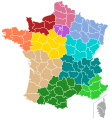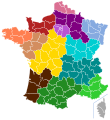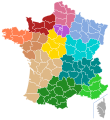Regions of France
| Region Région (French) | |
|---|---|
| Category | Unitary State |
| Location | French Republic |
| Number | 18 |
| Possible status |
|
| Additional status |
|
| Populations | 212,645 (Mayotte) – 12,005,077 (Île-de-France) |
| Areas | 376 km2 (145 sq mi) (Mayotte) – 84,061 km2 (32,456 sq mi) (Aquitaine-Limousin-Poitou-Charentes) |
| Government |
|
| Subdivisions | |
| This article is part of a series on the |
| Administrative divisions of France |
|---|
 |
| Administrative divisions |
| Intercommunality |
| Communes |
| Overseas France |
| Geocodes of France |
|
|
|
|
France is divided into 18 administrative regions (French: région, [ʁe.ʒjɔ̃]), including 13 metropolitan regions and 5 overseas regions.[1] The 13 metropolitan regions (including 12 mainland regions and Corsica) are each further subdivided into 2 to 13 departments, while the overseas regions technically consist of only one department each. The current legal concept of region was adopted in 1982, and in 2016 what had been 27 regions was reduced to 18.
As of March 2016, six regions have a temporary name: Alsace-Champagne-Ardenne-Lorraine, Aquitaine-Limousin-Poitou-Charentes, Auvergne-Rhône-Alpes, Bourgogne-Franche-Comté, Languedoc-Roussillon-Midi-Pyrénées, Nord-Pas-de-Calais-Picardie. Regions must make a decision about their name before 1 July 2016. Final decree will take place on 1 October 2016.
History
The term région was officially created by the Law of Decentralisation (2 March 1982), which also gave regions their legal status. The first direct elections for regional representatives took place on 16 March 1986.[2] In 2016, the number of regions was reduced from 27 to 18 through amalgamation.
Reform and mergers of regions
In 2014, the French parliament passed a law reducing the number of metropolitan regions from 22 to 13 with effect from 1 January 2016.[3]
|
|
The law gives interim names for most of the new regions by combining the names of the former regions, e.g. the region composed of Aquitaine, Poitou-Charentes and Limousin is Aquitaine-Limousin-Poitou-Charentes. However, the combined region of Upper and Lower Normandy is simply called "Normandy" (Normandie). Permanent names will be proposed by the new regional councils and confirmed by the Conseil d'Etat by 1 July 2016.[4] The legislation defining the new regions also allowed the Centre region to officially change its name to "Centre-Val de Loire" with effect from January 2015.[5]
|
Regions that merged:
| ||||||||||||||||||||||||||||||||||||
|
Regions that remained unchanged:
|
Overview of region division proposals
-
Édouard Balladur's proposal
-
Manuel Valls's proposal A
-
Manuel Valls's proposal B
-
President François Hollande's proposal
-
Regions as instituted by the National Assembly in 2014.
Regions and their capitals
Regions from 1982 to 2016
Between 1982 and 2015, there were 22 regions in Metropolitan France. Before 2011, there were four overseas regions (French Guiana, Guadeloupe, Martinique, and Réunion); in 2011 Mayotte became the fifth.
Role
Regions lack separate legislative authority and therefore cannot write their own statutory law. They levy their own taxes and, in return, receive a decreasing part of their budget from the central government, which gives them a portion of the taxes it levies. They also have considerable budgets managed by a regional council (conseil régional) made up of representatives voted into office in regional elections.
A region's primary responsibility is to build and furnish high schools. In March 2004, the French central government unveiled a controversial plan to transfer regulation of certain categories of non-teaching school staff to the regional authorities. Critics of this plan contended that tax revenue was insufficient to pay for the resulting costs, and that such measures would increase regional inequalities.
In addition, regions have considerable discretionary power over infrastructural spending, e.g., education, public transit, universities and research, and assistance to business owners. This has meant that the heads of wealthy regions such as Île-de-France or Rhône-Alpes can be high-profile positions.
Proposals to give regions limited legislative autonomy have met with considerable resistance; others propose transferring certain powers from the departments to their respective regions, leaving the former with limited authority.
Regional control
Number of regions controlled by each coalition since 1986.
| Elections | Presidencies | Map | ||
|---|---|---|---|---|
Left
|
Right
|
Other
| ||
| 1986 | 5 | 21 | – | 
|
| 1992 | 4 | 21 | 1 | 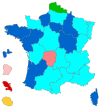
|
| 1998 | 10 | 15 | 1 | 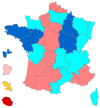
|
| Elections | Presidencies | Map | ||
|---|---|---|---|---|
Left
|
Right
|
Other
| ||
| 2004 | 23 | 2 | 1 | 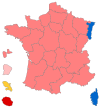
|
| 2010 | 23 | 3 | – | 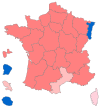
|
| 2015 | 7 | 8 | 2 | 
|
Overseas regions
Overseas region (French: Région d'outre-mer) is a recent designation, given to the overseas departments that have similar powers to those of the regions of metropolitan France. As integral parts of the French Republic, they are represented in the National Assembly, Senate and Economic and Social Council, elect a Member of the European Parliament (MEP) and use the Euro as their currency.
Although these territories have had these political powers since 1982, when France's decentralisation policy dictated that they be given elected regional councils along with other regional powers, the designation overseas regions dates only to the 2003 constitutional change; indeed, the new wording of the constitution aims to give no precedence to either appellation overseas department or overseas region, although the second is still virtually unused by French media.
The following have overseas region status:
- in the Indian Ocean (Africa)
- in the Americas
- French Guiana in South America
- Guadeloupe in the Antilles (Caribbean, Central America)
- Martinique in the Antilles (Caribbean, Central America)
- Saint Pierre and Miquelon (off Canada, in North America), once an overseas department, was demoted to a territorial collectivity in 1985.
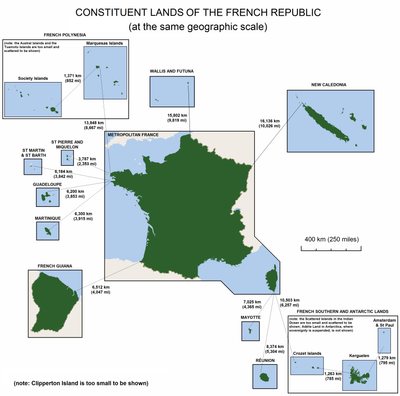 |
 |
See also
- Ranked list of French regions
- Administrative divisions of France
- List of French regions and overseas collectivities by GDP
- Flags of the regions of France
- ISO 3166-2:FR
General:
- Overseas
References
- ^ a b "Carte des Régions" (in French). INSEE. Retrieved 29 September 2009.
- ^ Jean-Marie Miossec (2009), Géohistoire de la régionalisation en France, Paris: Presses universitaires de France ISBN 978-2-13-056665-6.
- ^ La carte à 13 régions définitivement adoptée, Le Monde, 17 December 2014, accessed 2 January 2015
- ^ Quel nom pour la nouvelle région ? Vous avez choisi..., Sud-Ouest, 4 December 2014, accessed 2 January 2015
- ^ "Journal officiel of 17 January 2015". Légifrance (in French). 17 January 2015. Retrieved 10 March 2015.
- ^ a b These flags are not official.
- ^ "La nouvelle nomenclature des codes régions" (in French). INSEE. Retrieved 17 January 2016.
- ^ a b New name as of 17 January 2015; formerly named Centre.
External links
- Regions of France at Curlie
- Guide to the regions of France
- Local websites by region
- Will 2010 regional elections lead to political shake-up? Radio France Internationale in English
- Overseas regions




